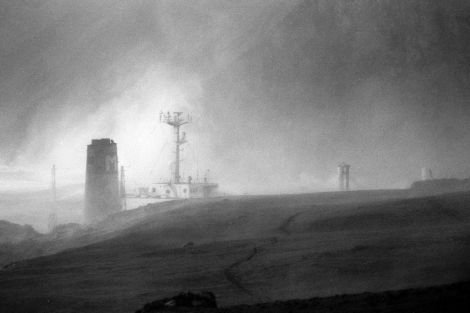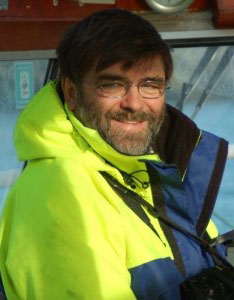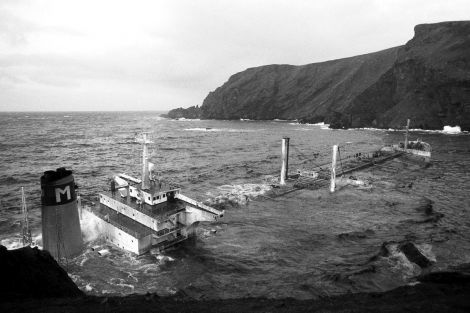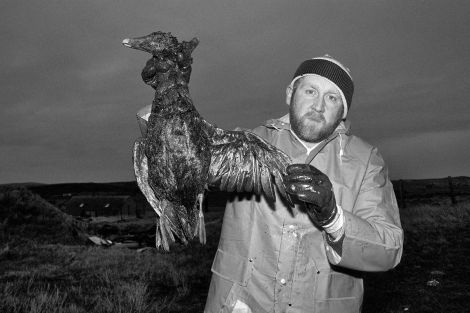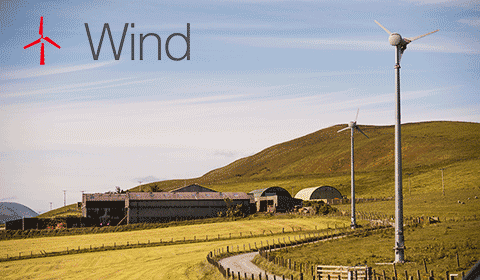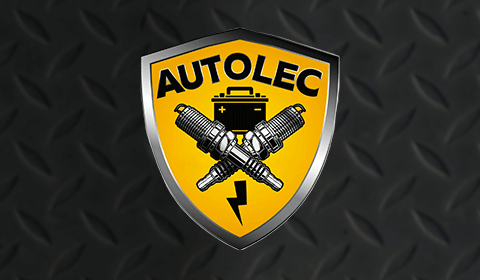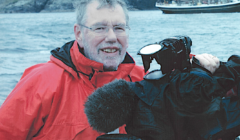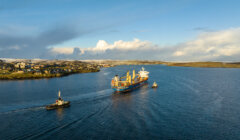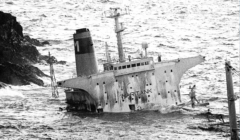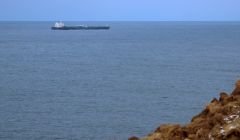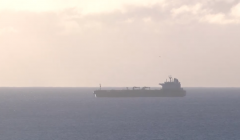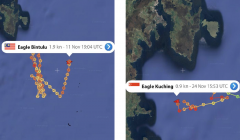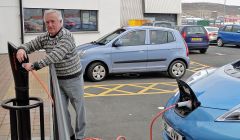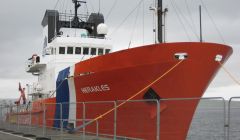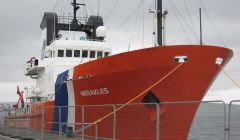Features / 25 years on – what REALLY happened on the Braer?
TWENTY five years ago this morning (Friday) the Liberian registered tanker Braer was drifting helplessly towards Shetland’s shores in horrendous weather conditions.
Hundreds of islanders watched in horror as the vessel drifted past Sumburgh and Scatness and eventually grounded at Garths Ness at about 11.15am spilling her entire cargo of 84,500 tonnes of crude oil and almost 2,000 tonnes of bunker oil.
To mark the anniversary, Shetland News is publishing a reviewed and recently updated investigation by Jonathan Wills into what caused the tanker to run aground:
Let’s start with the good news: the wreck of the tanker Braer on Garth’s Ness, Quendale, on 5 January 1993, at first seemed much worse than it turned out to be.
The ship was carrying twice as much oil as the official figure for what the infamous Exxon Valdez had spilled in Prince William Sound Alaska, just four years earlier and on the same latitude of 60 degrees north. Not surprisingly, most of us were horrified and extremely fearful, particularly when the ship became a total loss and the gale-driven fumes could be smelt as far away as Bressay.
One reason Shetland’s environment and wildlife escaped relatively lightly is because the hurricane that blew the ship ashore also blew away most of the oil. There’s still thick oil under some of the beach stones in Prince William Sound (I have a bottle of it on my desk) but you’d have to look long and hard to find any trace of the Braer’s muck on our shorelines, although there will be some in the buried sediments of sheltered bays. It also helped that we’re out in the ocean and exposed to the full fury of the Atlantic, whereas the Exxon Valdez grounded in an inland sea.
Become a member of Shetland News
Nature’s spring cleaning of most of the oil was the good news in 1993. Today there is more good news because, although most spill response equipment is still fairly useless, except in calm weather, we do now have a much better idea of what’s floating out there than we did on that awful morning a quarter of a century ago.
This is partly as a result of improvements resulting from the various inquiries into the causes of the Braer and partly because of technical advances that were happening anyway. All tankers are now obliged to report by radio to the Coastguards when they enter and leave the Fair Isle Channel; the local Coastguard station still doesn’t have radar cover of the Shetland coastline but it (and everyone with a mobile phone) does have access to a massive amount of information on ship movements through the AIS (Automatic Identification System) and GPS (Global Positioning System), which all large ships and many smaller ones are now obliged by law to carry.
Even a simple, free app like Marine Traffic on my iPhone tells me, as I write this at 9.10pm on 29 December 2017, that the small product tanker Bomar Quest (5770 gross tonnes) passed westbound through the Fair Isle Channel within the past hour, on a voyage to Barry, South Wales; while the much larger crude oil tanker Navion Scandia (72,753 gross tonnes) is approaching the channel from the north west at 12.1 knots, bound for Rotterdam with oil from the Glen Lyon field west of Shetland; and the NorthLink ferry Hjaltland is passing Stronsay on her way to Kirkwall. Both tankers are registered with flags of convenience, as was the Braer, and for the same reasons: mainly for tax avoidance and, sometimes, to profit by less stringent safety regimes.
So there’s no longer much chance of a tanker drifting for hours, undetected by the Coastguards (or anyone else). The risks of stranding and collision still exist, of course, and that is why a reluctant British Government is still paying for an emergency response vessel, or rescue tug, to be stationed in northern waters, an innovation that would probably not have happened without the Braer (1). Hopefully the tug will never be needed to help a large tanker in distress but the price of a single oil spill disaster, as we found out 25 years ago, can easily dwarf the annual bill for an emergency response vessel.
The improvements are welcome but the fact remains that the Braer stranding and spill need never have happened if existing safety procedures had been observed. As the California congressman George Miller said of the oil companies and the state and federal regulators, after the Exxon Valdez hit Bligh Reef on Good Friday 1989: “Oh, now they say they can make improvements and spend money on this and that, but where were they, the day before?”
Our story was wrong
One sunny day in 2001, eight years after the Braer tanker drifted aground on the southern tip of Shetland, spilling almost 85,000 tonnes of oil, an anonymous whistleblower left a plastic carrier bag on my boat in Lerwick, while I was in town having lunch. I was about to take it up to the tourist office’s lost property desk, in case one of my passengers had left it by mistake, but thought I would take a quick look inside first to see if there was anything that could identify the owner.
What I found in the bag was astonishing: it contained unpublished technical, legal and insurance papers about the wreck and proved that the book I’d written with Karen Warner about the disaster, Innocent Passage (Mainstream Publishing, 1993) was wrong: the information we’d been given by the authorities and the shipowner was misleading and/or incomplete. One of our sources, an insurance broker who spoke on condition of anonymity, had told me that the truth about the Braer was locked up in the vaults of an insurance company (he gave the name) and would never be made public.
The carrier bag’s information proved that the tanker was unseaworthy, by any normal standards, long before heavy seas damaged air vents and let water into the fuel. The American shipowner Michael S. Hudner had blocked the release of some evidence but the carrier bag contained previously unpublished logbooks from the Braer and from Statoil’s Mongstad oil terminal in Norway. These showed the vessel was unfit for a winter passage in the North Atlantic when she left Norway for Canada in January 1993.
Her steam boilers were badly corroded and their water supply dangerously contaminated. As a result, the engineers couldn’t warm up heavy fuel oil to burn in the main engine and auxiliary boiler as usual, and were using diesel instead. When the diesel became contaminated, the ship stopped and was blown ashore. But even if water hadn’t got into a fuel tank, the Braer risked running out of diesel and steam long before she reached her intended destination – Ultramar’s St Romouauld refinery in Quebec.
Secret papers revealed the truth
The documents, kept secret by law officers, the shipowner, a Norwegian ship inspection company, the Government’s Marine Accidents Investigation Branch (MAIB) – and even by Shetland Islands Council – also proved that a vital steam pipe burst in the engine-room at Mongstad. There’s no public evidence that the repair was physically checked, before the Braer left Norway, by an independent surveyor from Det Norske Veritas (DNV), a Norwegian ship inspection agency, as it should have been. If it wasn’t, that alone could have made the ship’s insurance invalid.
The shipowners and managers knew about the problems. That’s why they’d booked the tanker into a repair yard immediately after the planned voyage to Quebec. They should have fixed the Braer in Norway. The lives of the crew were hazarded, as well as the ship and her cargo, by doing vital repairs at sea.
Inquiries missed vital clues
Official inquiries, by accident investigators Capt. P. B. Marriott for the UK and Captain A. R. Goddard for Liberia, blamed bad weather and worse seamanship for the loss of the Braer after her engine stopped about 10 miles south of Sumburgh Head at 4.40am on 5 January 1993. But they didn’t look closely enough at what happened on board before she left Norway on her final voyage. And they appear to have missed or misinterpreted vital pieces of evidence. Rear Admiral John Lang, the then chief inspector of the Marine Accidents Investigation Branch (MAIB) of the UK department of transport, reviewed the new evidence. Although he had the power to re-open the inquiry, he did not do so. Instead, he described the papers I sent him as neither new nor evidence. Wrong again.
The papers recorded the fact that, within months of the 84,700-tonne crude oil spill, Shetland Islands Council handed public prosecutors compelling evidence of alleged pollution offences and breaches of maritime law. But in January 1994 the Crown Office in Edinburgh decided it wasn’t in the public interest to press charges. This was apparently because of the difficulty and expense of bringing witnesses back to a Scottish court once the crew had dispersed to their homes in Greece, the Philippines, Poland and the USA. Another consideration was that, under the Control of Pollution Act, extradition of defendants was impossible. Although the case was by then “time-barred” for a prosecution under that act, other charges could still have been brought. Possible alleged offences included withholding and/or failing to preserve evidence to an accident inquiry, making false statements to an inquiry; knowingly sending an unseaworthy vessel to sea, misrepresenting material facts to an insurance company and unlawful interference with the rights and duties of a ship’s master. But officialdom had decided to kill the story. I’d always wondered why. Now I knew.
If reckless negligence were proved, the Braer’s former owners and managers could have faced unlimited liability for compensation claims totalling over £127 million. The Braer’s own insurance policy covered only £4.9 million in pollution damages, less than four per cent of the total compensation claims eventually lodged. Because nothing was proved against Mr Hudner in court, he actually made a profit of over a million dollars out of the wreck, after insurers had paid him more than three times the 18-year-old, single-skinned tanker’s scrap value.
A careful re-examination of the Braer’s engine-room log for 3–5 January 1993, along with the other evidence hidden from the public and most councillors, suggests the boiler problems were indeed so serious that it might well have been cheaper to scrap her. But that would have meant losing the profit from carrying a cargo across the Atlantic on her way to a shipyard for urgent repairs.
Owner blocked publication
Mr Hudner, the former real estate lawyer who was a principal in the one-ship company that owned the Braer, is still in business, although he’s closed his old office in Stamford, Connecticut. When I tracked him down in Rhode Island in 2001 he refused to discuss the new evidence.
As far as Mr Hudner was concerned, the case was closed. In reply to my request for his permission to view DNV files about the Braer’s steam leak in Mongstad (assuming such documents exist) and to see the papers he submitted in evidence to the MAIB, he wrote:
“The owners participated in and gave every cooperation to two lengthy investigations – by the governments of Liberia and UK. These formal inquiries, which extensively examined and publicised all the facts of this accident concluded years ago.
“If you wish to reexamine [sic] the matter over again [sic] we … cannot do better than to refer you to the two enquiry reports, which speak for themselves …”
When asked again to reply to detailed technical questions, he wrote (in 2001):
“About eight years ago, several months after the Braer casualty, “Trade Winds” ran an article centered on the fax sent from the ship by Supt. Khan to the management company’s Technical Director. The title of the article was, “Braer Bashers Debunked”, and it reported the efforts gone through by underwriters to analyze the significance of Khan’s fax. The conclusion was, and it was publicly reported as such, was that there was nothing out of the operating norm with the ship, which re-confirmed the suitability and appropriateness of Braer’s setting forth on the voyage from Mongstad.
“This information was barely newsworthy in 1993; I fail to see why it would be newsworthy today, if presented accurately and with intellectual honesty, which I presume are your standards.
“I am not in agreement with much of what you have hypothesized; it simply does not fit the facts of the matter. Upon leaving Mongstad, the ship was seaworthy and safe. There was no safety issue regarding the steam plant.”
Unfortunately for Mr Hudner, it was now clear that the inquiries did not have “all the facts” (Statoil’s Mongstad nightshift logbooks, for example) and did not “extensively examine” some of the facts Mr Hudner did present to them – notably in the engine-room log of the Braer.
MAIB refused to help SIC
In preparing the case for prosecution, council officials had some difficulty in obtaining vital evidence. Some of the ship’s papers were lost in the wreck. Statoil was at first uncooperative but eventually released all its documents relating to the Braer’s last call at Mongstad. These papers included damning evidence about the state of the ship’s steam plant and her fuel consumption – evidence missed by the MAIB. Ironically, the MAIB refused to help the council, insisting that all the information it had was confidential.
Capt. Marriott argued that statements made by the crew weren’t statements but “declarations in confidence”. Even the MAIB’s copy of the Braer’s pipework layout drawings will remain an official secret until at least 2023, 30 years after the wreck. In 1999, New Labour’s transport secretary, John Prescott, a former seamen’s union official, amended the regulations to make it even more difficult for citizens to see the evidence upon which MAIB inquiries (which are held in private) base their findings.
Council staff saw key evidence
Despite being hamstrung by the MAIB, the council’s environmental health chief, Martin Hall, and his staff doggedly tracked down evidence from other sources, commissioned expert technical and legal opinions on it, and compiled a report for the council’s environmental services committee meeting, scheduled for 13 April 1994.
This raised very serious doubts about Mr Hudner’s version of events and, by implication, the conclusions of the MAIB and Liberian inquiry reports. It hinted at criminal acts by those responsible for the Braer’s last voyage. The inconsistencies between the deck and engine room logs and the subsequent statements of Mr Hudner, Captain Alexandros S. Gelis and the Braer’s engineer officers were so glaring that the SIC’s expert consultants on maritime law called the logs “fabrications”.
Green suppressed report
If presented to the committee, the report would almost certainly have “leaked” and become public, even if the meeting had been held in secret. At the last minute the council’s then chief executive, Malcolm Green, ordered it to be dropped from the agenda and the papers withheld from the committee. He did so with the approval of council convener Edward Thomason. Neither man gave a public explanation and both have since died, but former colleagues recalled that the government gave the council verbal assurances that the International Oil Pollution Compensation Fund (IOPCF) would make sure everyone was compensated quickly and in full.
That may be why council leaders decided there was no point in spending years pursuing Mr Hudner, Capt. Gelis and the insurers through the courts, as the Breton victims of the Amoco Cadiz spill had done. But the majority of councillors had no idea that the official version of events had been questioned by their staffers, and – in two lengthy critiques of Mr Hudner’s explanation for the disaster – by the prestigious Glasgow law firm of Maclay Murray & Spens.
Mr Hudner boasted after the wreck that his ship had been “first class”. He said she passed a US Coast Guard safety inspection at New York in November 1992. She did, but documents obtained under the US Freedom of Information Act show the American inspectors do not appear to have looked at the Braer’s main and auxiliary boilers and steam piping, although they did check the condition of the air vents to the fuel tanks and found them in good order. The last time the steam generation plant was fully inspected was in May 1992.
The trouble seems to have started around 11 December 1992, when the Braer arrived in New York with a cargo from Mongstad. The ship had been working very hard all year, steaming over 70,000 miles on voyages to the USA, Canada, Poland, Germany, Norway, the UK (including Shetland), Algeria and Venezuela.
Stays in port were typically three days for loading and a maximum of five days for unloading. Inspections, maintenance and repairs appear to have been done without interrupting sailing schedules. But the Braer remained for an unusually long time in New York, at an Exxon berth and later at anchor, 10 days in all. In January 2001, in his first interview since the loss of his ship, Capt. Gelis told me at his home in Piraeus that he remembered Exxon inspectors coming aboard but couldn’t say if Exxon terminated the Braer’s charter at this time or whether it had just come to an end and the ship was waiting for new orders.
Not a happy ship
Certainly all was not well in the engine room. According to the MAIB, the first assistant engineer left “at short notice” during the protracted stay at New York: “…it appears that there had been personal differences between him and the chief engineer, who said that the first assistant engineer had wanted to leave because there was too much work to do.”
Neither the MAIB nor the Liberian inspector appears to have tried to trace this officer or ask him why he resigned. Capt. Gelis recalled that he left because he was “unhappy with the condition of the engine”. His successor did not join the ship until she arrived in Mongstad on Hogmanay 1992, so the Braer crossed the Atlantic for the last time without her full legal complement of engineering officers, a defect noted by both inquiries. None of the officers in the engine room when she sailed from Mongstad had been on board for very long. Some of them may not have been fully familiar with the ship’s pipework. The longest-serving, second assistant engineer Rudy S. Ilad, had joined in May 1992. Third assistant engineer Ulpianio C. Roldan had been aboard since October and chief engineer Ioannis G. Vloutis only since November. Vloutis had limited experience in tankers and, crucially, of their steam systems.
Why tankers rely on steam
Ships like the Braer can’t run without steam. They use it to boil heavy fuel oil until it’s runny enough to burn in the main engine. Otherwise they’d have to burn diesel all the time – more than twice as expensive as fuel oil. The steam also powers pumps, winches and anchor windlasses, and keeps the crew’s accommodation warm. Because of the danger of explosion and fire, steam does many jobs on an oil tanker that on a conventional freighter would be done by electrical equipment.
At sea, the Braer would normally raise steam in her “economiser” or main boiler, heated by the main engine exhaust. If for any reason that wasn’t enough, there was a second, auxiliary boiler that burned either heated fuel oil or diesel. This was usually only fired up in port, when higher pressure steam, and lots of it, was needed to drive the mooring winches and work cargo and ballast water pumps.
The MAIB noted that both boilers were only working at 85 per cent efficiency, presumably (although this was not stated) because about 15 per cent of their tubes were corroded and/or cracked and therefore blocked off. The “internals” of the “economiser” boiler had been inspected during Atlantic crossings in November and December, but apparently not yet repaired.
Since leaving New York on 21 December the ship had been using the auxiliary boiler on passage to maintain steam pressure. This might be expected when, as on 3 and 4 January, the main engine was running very slowly because sea speed had been reduced due to the storm, but to keep the auxiliary boiler working while at sea was unusual and confirms there were serious problems.
Boiler trouble at Christmas
The bunker report on her arrival in Norway shows that during this passage from New York to Mongstad the Braer used three times as much diesel as usual. It looks as if she was having to burn diesel in the auxiliary boiler to make enough steam to heat the fuel oil. Or it may be that the main engine ran for a while on pure diesel or a mix of diesel and fuel oil. There was a leak in the water pipe feeding the boiler, three days before arrival in Mongstad. The MAIB inspectors confused this fault (which was by no means minor, in view of the Braer’s difficulty in distilling enough fresh water for her boilers) with the much more serious incident that occurred after she docked at Mongstad’s Jetty One in the last hour of Hogmanay 1992.
The steam line bursts
Eight minutes into the New Year, the Braer tried to use a steam-driven pump to empty her ballast water tanks. The main steam pipe between the boilers and the manifold burst at 16 times atmospheric pressure and at a temperature of 345 degrees Celsius. Deballasting and loading were delayed 19 hours for repairs.
The Braer’s owners and managers were in daily telephone contact with the ship and must have known about this because Statoil, the Mongstad terminal operators, lodged a formal protest about the delays in loading. The repair was under the direction of Mr Hudner’s shore-based superintendent engineer, Qamerul Khan, who boarded the ship on New Year’s Day with a “riding crew” of four Polish fitters, to “familiarise” himself with the vessel, tackle “a backlog of repair and maintenance” and prepare the ship for five days in a repair yard after discharging her cargo in Quebec. That’s what they told the MAIB. Capt. Gelis said Khan was there “to fix the boiler’s pipes” and had phoned Mr Hudner’s office about the steam problems.
An engineer of Mr Khan’s qualifications (he held an extra first class certificate of competency as marine engineer) must have known that repairs to such a critical piece of equipment should have been physically checked by Det Norske Veritas (DNV), the Norwegian ship inspection and classification society that issued the Braer’s certificates of seaworthiness. There were no DNV surveyors resident in Mongstad. They had to drive the 80km or so from the Bergen office. Some classification society surveyors would have insisted on a new pipe being fitted, after testing it to 1.5 times working pressure, rather than welding up the cracks in situ, as was done in the Braer‘s engine-room.
Was the Braer “in class”?
So was this work properly certified? If not, the ship was “out of class” – technically unseaworthy – and therefore uninsured. Capt. Gelis and the ship’s Norwegian agents, whom I also interviewed, had no recollection of anyone from DNV coming aboard to supervise or certify what was, in nautical terms, the equivalent of a heart valve operation for a human. The MAIB said in January 1994 that all the ship’s certificates were “in order and fully up to date” but later admitted it too had no record of such an inspection and therefore didn’t know if DNV physically inspected the repair or not. Despite repeated requests, DNV refused to answer any of my questions about the Braer.
It believed there was a continuing duty of confidentiality to The Braer Corporation of Monrovia, eight years after that one-ship company ceased to exist, and that this posthumous (and probably imaginary) obligation took precedence over the public’s right to know the facts. With DNV, as to some extent with MAIB, what Mr Hudner said went and Mr Hudner said “no” to publication. The question remains: if such a DNV inspection certificate did exist, why didn’t Mr Hudner produce it to the MAIB, as irrefutable proof that his ship really was “first class” and his insurance therefore valid?
Steam plant was rotten
What Mr Hudner, DNV and the MAIB could not conceal, however, was that the 18-year-old tanker’s steam system was defective and unreliable. Logbook entries, kept secret until I published them in 2001, recorded the engineers continually dosing the boiler water with chemicals to counteract corrosion. The water was grossly contaminated with salt. The chloride limit should have been a maximum of 300 parts per million (ppm). The actual boiler water values recorded in the log were 1,620 ppm at 10am on 3 January, just as the Braer was making ready for sea, and 2,080 ppm by the next morning, having got much worse after departure. These levels were dangerously high. The problem was exacerbated by the fact that the “make-up” water in the tank feeding the boiler was itself heavily contaminated. The recommended maximum salt content for boiler feed water is only 10ppm. At 10am on the 3rd the level in “fresh” water coming out of the condenser was as high as 620ppm. Even diluted in the feed tank it was still 40ppm – four times the safe limit.
To reduce and control this contamination, the engineers would have to “blow down”, or empty, the boilers frequently. The chief engineer wrote orders to this effect in the margins of the log. This would further increase water consumption and it’s clear the Braer was already using more than her fresh water generator could produce. Even without seawater contamination of the diesel, the tanker would have run out of boiler water in a week or less, before she reached Quebec. And if there’d been any recurrence of problems with her unreliable steam plant (very likely, given the state of the boilers) then she’d have run out of diesel even earlier – three or four days out into the Atlantic. In these circumstances the sensible thing would be to go to anchor and make a serious attempt to fix the deficiencies.
Or, if that proved too complex or expensive, to tow her to a repair yard or a shipbreaker’s. But there was nowhere to anchor a ship the size of the Braer at Mongstad – the fjord is far too deep. It was far too windy to tow her out to sea and along the rock-strewn Norwegian coastline to the nearest repair yard. And there was a queue of other ships waiting to use Jetty One. So the Braer sailed under her own steam – or what was left of it.
Did it make any difference?
On the evidence, the Braer was unfit for sea – but did these defects really make any difference to what eventually happened? Let’s assume the Braer’s steam plant had been in perfect working order when she left Mongstad: as soon as she was cleared away for sea (at slow speed because of the weather), the main engine would be switched from diesel to heavy fuel oil. The economiser boiler should have been making enough steam to heat the fuel oil and keep the ship warm. The auxiliary boiler, also using fuel oil heated by the steam, would have met any extra demand. Diesel would only have been required for the electricity generator, at the rate of about 3.5 tonnes a day (compared with the 55+ tonnes needed if diesel had to be burned in the main engine and boiler all the time). If seawater got into the diesel it would still have been a serious problem but unlikely to be fatal. Because of the smaller volumes of fuel involved, there’d have been time to drain it off and filter it out. That would certainly have made a difference, all the difference between an annoying and expensive delay and an environmental disaster that could easily have become a fatal catastrophe for the 34 people on board (and maybe for the brave helicopter crew who were to rescue them in appalling conditions).
Both the MAIB and Liberian inquiries largely accepted the plausible scenario sketched by Mr Hudner in his carefully crafted press release 20 days after the wreck. The council’s solicitors, however, were quick to spot the subtle word-smithing and legalistic finesse in this document’s composition. Without ever actually saying so, he encouraged the belief that the loss of the Braer (“this accident”, as he still calls it) was the result of an Act of God – the storm rather than any defects in his ship or employees.
Skipper kept in the dark
Reality didn’t exactly follow Mr Hudner’s script. At noon GMT on 3 January 1993 Gelis, quite unaware of the developing crisis in the engine-room, sailed out into a southerly gale force nine and 30-foot seas. It was so rough that the pilot was unable to transfer to the pilot cutter at the usual pilot station and instead left the tanker early, after giving Capt. Gelis a course to steer.
In the first 24 hours, according to the deck log, the Braer covered only 60 nautical miles, an average speed of 2.5 knots. Khan and chief engineer Vloutis were busy compiling a list of work they planned to do on the ship during the voyage and in the repair yard after arrival in Quebec. On the afternoon of 4 January Khan faxed this list to Mr Hudner’s office. There was probably at least one radiotelephone voice call about it as well. The MAIB has a copy of the fax but this is one of the many documents which Mr Hudner, an American citizen, can order British civil servants not to show to British citizens (or to anyone else) until 2023.
The MAIB’s report didn’t say what was on the list. It merely noted that the repairs would “not necessarily” have prevented the ship leaving Mongstad. In other words, they might have done. But when the report was written the MAIB inspectors, of course, had no idea there’d been a burst steam main on board or that they’d been misled as to the true nature of the repairs to the steam plant. Nor had they understood the extent or seriousness of the boiler contamination.
Within a day of leaving Norway, storm waves tore off four steel pipes welded to storage racks on the port side of the ship’s inert gas room – the housing below the smokestack. The chief engineer later said he’d warned Capt. Gelis this might happen. The heavy pipes rolled around on deck, damaging air vents from the fuel tanks below. That almost certainly let seawater into the port side diesel fuel tank, and maybe the port fuel oil tank too.
There was still plenty of clean diesel in the starboard storage tank. Its air vents were undamaged. Although the valves between the two storage tanks were open and the contamination was spreading, there were still two barriers designed to keep water out of the all-important diesel service tank which fed the electricity generators and, when required, the main engine: first a settling tank where water could be drained off; then the fuel purifiers – filters and a centrifuge to remove any remaining water. There was a similar arrangement for the heavy fuel oil tanks – which also contained steam-filled pipes to heat the oil.
It was too dangerous to send crewmen on deck to secure the loose pipes and repair the damaged air vents – the waves crashing on board every 10 seconds were up to 20 feet above the deck. But the diesel in the service tank remained uncontaminated for at least 12 hours after seawater entered the port fuel tank and was pumped from there to the settling tank. So the purifiers must have been working. The Liberian report noted that they appeared to be operating normally at least until 4am on the 5th.
By the evening of Monday 4 January it seemed things were settling down. The weather was storm force 10 but the main engine was at last running at normal sea speed (about 107 rpm). Now a new problem appeared – the boiler water level alarms started sounding irregularly and threatening to trip the system out – not surprising in view of the quality and quantity of feed water, noted above. At 9pm the duty engineer shut down the auxiliary boiler, to try to repair the alarm system. Mr Hudner misleadingly called this a “routine adjustment” – it was nothing of the kind. The engineer switched the fuel from heavy oil to diesel, which ought to make the boiler easier to start again.
The cascade of failure begins
At this point things started to go badly wrong: the steam pressure and fuel oil temperature dropped, possibly because of a new steam leak. By 10.30pm the engineers were trying to re-start the auxiliary boiler. The flame kept going out. There was water in the diesel. This was because the auxiliary boiler wasn’t fed with purified diesel from the service tank but directly from the diesel settling tank, with no filter in the line between tank and burner.
By 11.33pm, or perhaps earlier, the fuel oil was so cool and sticky that they had to switch the main engine back to pure diesel. This was filtered fuel from the service tank, so the engine ran normally – until water got into the service tank around 4am. The contamination of the settling tank was already so serious that the engineers ought to have raised the alarm and made contingency plans to avoid loss of the diesel generators that supplied the main engine’s electric fuel and lubricating oil pumps. But still no-one called the chief engineer, let alone the captain, who was upstairs watching a video with Khan.
Mr Hudner’s version is that Superintendent Khan didn’t discover water in the fuel until a “routine” visit to the engine-room at 2am on 5 January, by which time the engineers had been battling boiler failure for over three hours. Capt. Gelis recalled Mr Khan leaving the captain’s room to visit the engine-room at midnight, when the 12-to-4 watch came on duty. He said Mr Khan came back upstairs an hour later and returned to the engine-room at 1.20am, without mentioning any serious problems.
After being awake almost continuously for 36 hours, Capt. Gelis turned in at 2am – precisely the time when, according to Khan, the seriousness of the situation first became clear. No-one thought to tell Capt. Gelis his ship’s life-support system was collapsing. If it had been reckless to leave Norway in a ship with an unreliable steam plant, the contaminated fuel problem could be put down to bad luck or, at worst, carelessness. But the response of the Braer‘s engineer officers to the crisis looks like negligence.
They should immediately have prepared a clean fuel supply for the generators, if necessary by hand-pumping diesel into 45-gallon drums. Instead, they spent several hours trying to drain the water out of the fuel and re-light the auxiliary boiler, only to find more water each time. As both inquiries pointed out, they were treating the symptom, not the root cause.
Despite standing orders for the officers to call him if they had any concerns at all, no-one woke Capt. Gelis until 4am, when the engineers reduced engine revolutions to conserve dwindling stocks of clean diesel. At 4.10am Mr Khan came to the bridge and told Capt. Gelis what the problem was. But he still appeared confident that he and the chief engineer could fix it. They couldn’t. Half an hour later the main engine faltered and stopped. Minutes after that, the slug of water from the service tank killed the electricity generator. The standby generator should have kicked in automatically. It should have been fed from a separate, emergency tank. Either this was also contaminated or, as 1st assistant engineer Paerros would later tell Capt. Gelis, the standby generator’s fuel line had been “destroyed”. The air compressors, essential if the main engine was to be re-started, appear to have shared the same contaminated fuel supply.
The fuel mystery remains
So how did water get into the service tank?
The MAIB looked at the possibility that the engineers, in a panic and suddenly realising the service tank was about to run dry, had deliberately by-passed the fuel purifiers and inadvertently pumped up watery fuel from the starboard storage tank (by now contaminated because of that open line to the port tank). The MAIB rejected this idea simply because the engineers said they hadn’t done it, but it remains a strong possibility.
The MAIB didn’t mention another plausible theory: that the cap had come off the “sounding tube” from the deck – a pipe used to dip the service tank to see how much fuel it contained. If the screw thread of the cap was damaged, or if someone didn’t tighten it properly before leaving port, it could have worked loose and let seawater in. The last time the cap had been unscrewed was in Mongstad on the morning of 3 January – when the cargo inspector checked the fuel level before the Braer left on her final voyage.
The MAIB plumped for what seems a less likely explanation: they postulated that one of the loose pipes must have worked its way across to the starboard side of the ship and somehow damaged an air vent shared by the diesel settling and service tanks. To do this, the pipe would have had to get around or over substantial deck bollards, sidle past a gantry used for loading stores, hop over a pipeline that ran along the deck parallel to the deckhouse bulkhead, damage the air vent and then make its way aft again – where indeed one of the smaller loose pipes did end up, but behind the bollards, not in front of them. In doing so the pipe would undoubtedly have caused extensive damage to the gantry, the deck line and the starboard rails. According to the best witness, however, all these structures were still undamaged when the Braer went aground. On the port side, similarly-sized pipes had demolished a lengthy section of rail, as well as the air vents. The MAIB, having initially identified the loose pipes as the obvious and primary cause of the trouble, had in fact failed to prove the source of the water in the service tank and was left with conjecture.
A “first class” ship?
The MAIB unquestioningly accepted Mr Hudner’s assertion that the Braer was a well-found ship and blamed the wreck on failures in the chain of communication rather than the incompetence of individuals. The evidence revealed in 2001 suggested, at the very least, that this view should be revised.
In 2001 it also became clear that Capt. Gelis, severely criticised by both inquiries, didn’t have a chance to defend himself. He was supposed to have 28 days to read the draft MAIB inquiry report prior to publication and another 28 days to draft his own version if he and the inspector could not agree. He told me he never saw the report until after publication. The reason for this is unclear and may not be the MAIB’s fault but it does mean that all the information Capt. Gelis gave to the inquiry was dictated with Mr Hudner’s company lawyer sitting next to him. That hardly makes for fearless, untainted, independent testimony. He’d never seen the Liberian report until I showed it to him in Piraeus in January 2001. I had wondered why he had kept his ticket. Now I knew: he knew too much.
Blame the Old Man
On the face of it, Capt. Gelis was culpable for what happened after Khan and Chief Engineer Vloutis got round to telling him about water in the fuel, if not for the cumulative mechanical breakdowns of which they’d told him nothing.
At 4.10am on 5 January, in spite of the obvious and imminent danger of total power failure, he ploughed on through the storm into the north Fair Isle Channel, an area with some of the worst seas in the world. Twenty minutes later, when he eventually understood how bad the fuel problem was and, perhaps, what little chance Khan had of fixing it, he altered course. But instead of turning downwind for the nearest shelter, on the north-east side of Shetland, he headed the ship into the wind and steered for superintendent engineer Khan’s suggested anchorage, the Moray Firth, over 100 miles to the south. As the MAIB pointed out, there was no chance of reaching it. Maybe he wasn’t thinking straight. He was exhausted, after all.
But at 4.40am, when the huge ship lay dead in the water, drifting before storm and tide at two miles an hour towards the rocks 10 miles away, surely he should have broadcast a “Mayday” distress message? The ship’s first radio call was instead for Khan to talk to the ship manager’s office in Stamford, Connecticut. Not until 28 minutes after the power blackout did the Braer’s radio officer speak to the coastguards, with a non-urgent message. The position the ship gave was wrong by at least five miles. Then Khan spoke to the US again. Capt. Gelis said Khan was asking the owners’ permission to call for help. In other words, as both inquiries hinted, Capt. Gelis was no longer in full command of his ship. It’s all very well to say, as the investigators did, that he should have asserted his authority as master; the fact is that the easy availability of the radiotelephone (even on a ship with only emergency power) has given “the men from the office” equal and sometimes greater power than the captain. That’s maybe not the legal position and it certainly isn’t desirable but it was the reality on the Braer.
Not until 44 minutes after the blackout did Capt. Gelis speak directly to the coastguards. He immediately asked for a tug. His English is poor but the request was clear. The coastguard officer who took the call inadvertently confused the situation worse by asking who would pay for it. At this stage, it is important to note, the coastguards were under the impression that this was a precautionary towing operation – strictly speaking, a commercial matter between the tanker’s owners and a tug company – rather than a rescue mission. The rules in force at that time did not give the coastguards authority to insist upon a tug.
If the engineers had done their duty and told Capt. Gelis the truth about the problems when they began (as far back as 28 December 1992), a wise captain would have refused to sail; if they’d alerted him by 11.30pm on 4 January, when they first knew about the water in the fuel, he could have “dodged” east of Shetland and not entered the Fair Isle Channel; and even if they’d told him at 2am on the 5th he could still have called for help in time – and then informed the office in Connecticut. It was the chief engineer’s fault, and Mr Khan’s, but the Old Man had to take the blame.
The police and the fatal delay
Capt. Gelis certainly bears no responsibility for the final act of the tragedy: after the heroic helicopter rescue of the tanker’s crew (2), there was a delay – for 90 crucial minutes – in putting men back aboard the tanker when the tug Star Sirius did eventually arrive at the Braer, shortly after she’d drifted past Horse Island (which she’d been expected to hit). The delay seemed inexplicable at the time and the official version was that the coastguards were to blame.
Contemporary records, seen for the first time by the author (3), prove that the police were responsible for the disastrous delay. After the rescue they corralled Capt. Gelis and his crew at a nearby hotel. After the tanker missed Horse Island Capt. Gelis and some of his crew volunteered to fly back to his ship and try to take a line from the tug. The helicopter was ready to go. The coastguards were desperately trying to phone Capt. Gelis. But junior police officers with no nautical knowledge or awareness of the urgency of the situation just followed their orders and failed to respond in time to the coastguards’ increasingly urgent requests to speak to the distraught captain.
By 11am, when the helicopter did eventually land the brave volunteer salvage crew on the Braer’s stern, it was all too late. As we know so well, the tanker grounded and broke up, spilling her entire cargo and bunkers.
When I last wrote to him, in 2001, Mr Hudner was still in business as a “shipowners’ representative” in Portsmouth, Rhode Island, where Khan, unlike Capt. Gelis, still worked for him. Mr Hudner had a nice house just up the road in Bristol, overlooking the bay. According to a mutual acquaintance whom I chanced to meet recently, his business took a hit during the 2008 financial crisis and he has also suffered two family tragedies. I’m sorry about that and I sympathise but I still think he should apologise for what was done in his name, 25 years ago.
With no prosecution, and no prospect of Mr Hudner or his insurers paying for the damage, Shetland’s fishermen, fish farmers and crofters were thrown back on the IOPCF, which boasts of never paying out more than 60 per cent on valid claims (4). The tourist industry got almost nothing.
Third party cover?
When you take a car on the road you must have third-party insurance. Not if you take a loaded oil tanker out on the ocean and cause an oil spill. The IOPCF picks up some of the tab if you can’t or won’t – even if you or your captain are grossly and recklessly negligent. The fund gets its money from a levy on oil companies, not on shipowners.
But the IOPCF managers hadn’t reckoned on the Braer costing more than their 1993 spending limit of £57 million per spill. In 1995, after approving £47 million for some 2,000 claimants whose livelihoods and property were damaged by the Braer, the fund froze payments when there wasn’t enough cash left to cover all potential liabilities. The fund has since raised its cash limit for future spills, but that didn’t help those Braer claimants who were still waiting and will now wait for ever. Similar shortfalls have affected claimants after other pollution incidents.
The payments freeze was lifted in May 2000 after Shetlanders and others had abandoned over 140 claims worth a total of £71 million – some because they lost court cases against the fund, couldn’t afford lawyers for appeals or the government wouldn’t give legal aid. There were no payments for damage to wildlife, such as the thousands of seabirds killed by the spill. British law has yet to catch up with American practice on compensation for natural resource damages.
The unanswered questions
There are questions still unanswered:
- Why didn’t the Crown bring charges under the Control of Pollution Act, at the very least? To say nothing of falsifying logbooks, conspiring to defraud, concealing evidence, and reckless negligence endangering a ship, crew and cargo in British territorial waters?
- Why don’t insurers insist on better inspections of the ships they cover, to find and correct mechanical defects before they turn into floating disasters like the Braer’s engine-room on the night of 4/5 January 1993?
- And why does the UK Government still allow tankers to sail through our fishing grounds and environmentally sensitive coastal waters without all-risks insurance?
It seems that tankers still don’t carry all-risks insurance because the international compensation fund pays most of the costs of spills, not the shipowners. The law needs changing, to make sure that polluters really are fully covered and really do pay up. The European Union is now considering making all-risks insurance compulsory. The IOPCF is strenuously and aggressively resisting it. Expect action sometime around 2033.
Notes:
(1) The late Lord Donaldson, in his inquiry, said emergency response vessels were not needed because the traffic around Shetland was not as great as in the English Channel (where he was a weekend sailor). The noble and learned lord apparently did not understand that it only takes one to cause a disaster. Besides, traffic volumes through the Fair Isle Channel have greatly increased since 1993.
(2) A textbook lifesaving operation for which officers at Shetland Coastguard HQ in Lerwick received no official recognition, despite their primary role being the saving of life rather than salvage.
(3) The records include previously inaccessible correspondence and transcripts of radio calls, phone messages and telexes, first seen by the author in 2010, courtesy of a confidential informant. The original text of this paper was revised in the light of the new information.
(4) The IOPCF used this figure in reports to its annual meeting in London in November 2016, which I attended as an observer on behalf of the EU’s Conference of Peripheral Maritime Regions.
Sources:
The sources of information for this article included the following (in order of citation): * denotes source who wishes to remain anonymous for professional reasons.
1. M. S. Mr Hudner – letters to J.Wills, 15/01/01 and 28/02/01;
2. Braer Engine-room Log, 3-5/1/93;
3. Braer Deck log, 3-5/1/93;
4. *Anonymous senior marine engineer (A.M.I.Mar.Eng., A.M.R.I.N.A) – “Technical Commentary on Braer Logs”, 25/9/00;
5. *Anonymous senior marine engineer (C.Eng., M.I.Mar.E., M.R.I.N.A.) with many years’ experience of steam plant operation and maintenance – “Braer: Notes on Steam Plant Condition”, 16/01/01;
6. Capt. A. S. Gelis – interview with J. Wills, Piraeus, 7/01/01;
7. *Anonymous shipping agents, Norway – telephone interviews with J.Wills, January 2001;
8. Rear Admiral J. Lang, Principal Inspector, Marine Accidents Investigation Branch (MAIB) – letter to J. Wills, 27/12/00; 10/01/01; 19/01/01, 24/01/01;
9. MAIB Report on Braer, Jan. 1994;
10. Liberian accident inquiry report, 17/1/94;
11. MAIB List of Documentary Sources for the Braer Investigation – supplied 7/11/00;
12. Shetland Islands Council – complaint to the procurator fiscal at Lerwick, 13/10/93;
13. Sally Gregory, former claims officer, International Oil Pollution Compensation Fund (IOPCF) – telephone interview with J.Wills, 27/9/00;
14. Statoil shift logs, Mongstad terminal, 31/12/92-01/01/93;
15. SGS/Redwood – Bunker Report No. 92-PE-2085 to Statoil from Inspector Torstenrud, 3/1/93;
16. *Anonymous marine engineer for a major classification society, London – interview with J. Wills, January 2001;
17. *Anonymous marine surveyor for a major classification society, Aberdeen – interview with J. Wills, January 2001;
18. Capt. P. B. Marriott, letter to Shetland Islands Council, 17/06/93;
19. Merchant Shipping (Accident Reporting and Investigation) Regulations, 1999, Section 9 (1);
20. Maclay Murray & Spens reports to SIC dated 2/7/93 & 8/9/93;
21. M. Hall, suppressed report to SIC environmental services committee, 13/4/94;
22. J.Wills telephone interviews Sept. 2000 with Major W. Anderson (SIC vice-convener, 1993); Mrs J. Easten (former Chair of the SIC environmental services committee, 1993-94); and councillor F. Grains;
23. B+H Ship Management – press release, 25/1/93;
24. US Coast Guard – inspection report on the Braer, New York, 11/11/92;
25. Statoil – Vessel Experience Factor (VEF) report, 01/01/93;
26. Captain A. Gelis – revised statement to MAIB, 15/1/93;
27. SIC Marine Operations log, Oct. 1992;
28. Plan of Braer’s sister ship with Locations of Pipework and Air Vents, SIC, 13/4/94;
29. Plan of Standard Tanker Fuel Layout, SIC, 13/4/94;
30. Statoil letter of protest to B&H Ship Management, 1/1/92;
31. *Anonymous Statoil official – telephone interview with J.Wills, 18/01/01;
32. Helge Kjeøy, head of section, class systematics, support & monitoring, Det Norske Veritas, Oslo – correspondence with J. Wills, 25-27/9/00 & 17-24/01/01;
33. Engine-room log of the Braer, 3-4/1/93;
34. Institute of Marine Engineers – “Running and Maintenance of Auxiliary Machinery”;
35. Chief engineer I. Vloutis – statement to Shetland police, 5/1/93;
36. 3rd asst. engineer U. Roldan’s statement to Shetland police,6/1/93;
37. Supt. Q. Khan – statement to Shetland police, 6/1/93;
38. 2nd asst. engineer R. Ilad – statement to Shetland police, 6/1/93;
39. 1st engineer D. Paerros – statement to Shetland police, 6/1/93;
40. Hydrographer of the Navy – North Coast of Scotland Pilot book;
41. Hydrographer of the Navy – Tidal Stream Atlas for the Shetland Islands and Tidal Predictions for 1993;
42. Hydrographer of the Navy – Admiralty Charts Nos. 3283 & 2182C;
43. HM Coastguard – Transcripts of coastal radio traffic, 5/01/93;
44. Recommendations to the European Parliament and Commission from the Conference of Peripheral Maritime Regions seminar on Maritime Safety, Brest, 2-3/11/00.
45. Mans Jacobsson, director, International Oil Pollution Compensation Fund – interview with J. Wills, 05/02/01.
46. Former MCA employee*.
Become a member of Shetland News
Shetland News is asking its many readers to consider paying for membership to get additional features and services: -
- Remove non-local ads;
- Bookmark posts to read later;
- Exclusive curated weekly newsletter;
- Hide membership messages;
- Comments open for discussion.
If you appreciate what we do and feel strongly about impartial local journalism, then please become a member of Shetland News by either making a single payment, or setting up a monthly, quarterly or yearly subscription.






